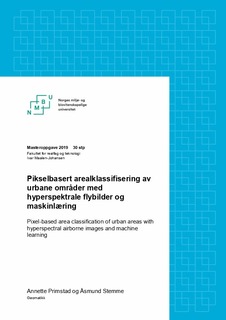| dc.contributor.advisor | Maalen-Johansen, Ivar | |
| dc.contributor.advisor | Finsland, Webjørn | |
| dc.contributor.advisor | Burud, Ingunn | |
| dc.contributor.author | Primstad, Annette | |
| dc.contributor.author | Stemme, Åsmund | |
| dc.date.accessioned | 2019-10-02T07:21:19Z | |
| dc.date.available | 2019-10-02T07:21:19Z | |
| dc.date.issued | 2019 | |
| dc.identifier.uri | http://hdl.handle.net/11250/2619709 | |
| dc.description.abstract | Mapping area types with remote sensing may be challenging in densely populated urban areas because of large variations in area types. The technique of airborne hyperspectral images is entering the remote sensing industry, but these types of data contain so much information that it may be difficult to fully obtain the potential such data provides. Many looks to machine learning for a solution to solve this obstacle. In this thesis, hyperspectral datasets over the city of Oslo were used to test out pixel-based area classification, and to consider and compare the potential of a few chosen machine learning algorithms.
The images used for this study were a radiance and a reflectance dataset, in both the VNIR and SWIR range. VNIR had a spatial resolution of 0.3 m and consisted of 186 bands. SWIR had a spatial resolution of 0.7 m and consisted of 288 bands. We then had a total of 474 bands to work with. The goal was to investigate how well the three machine learning algorithms CNN, SVM and logistic regression performed on area classification with the datasets. The various datasets were also compared to see which one gave the best results for our chosen test area.
We picked two areas of interest, one for training and testing the models of the algorithms, and one for final validation. Because the selected algorithms all were supervised classifiers, we prepared ground truth for the two areas. It was chosen to inspect permeable and impermeable surfaces and distinguish between a few classes within vegetation and stone- based materials. These chosen classes were asphalt, concrete, grass, gravel, shrub and tree. For classifications single pixels only was used, a lower limit for each class was set to at least 15,000 pixels.
A radiance set of 466 bands performed best and was therefore selected for final validation. For classification with six classes, CNN gave an accuracy of 51% and a kappa coefficient of 38%. SVM gave an accuracy of 74% and a kappa coefficient of 65% and logistic regression an accuracy of 86% and a kappa coefficient of 80%. This result shows that it is possible to classify urban areas with hyperspectral images. On the 6 selected classes with this dataset, the simplest algorithm, logistically regression, performed best. | nb_NO |
| dc.description.abstract | Kartlegging av arealtyper med fjernmåling kan være utfordrende i tettbebygde byområder på grunn av store variasjoner innen arealtyper. Flybårne hyperspektrale bilder er på vei inn i fjernmålingsindustrien, men disse inneholder så mye informasjon at det kan være vanskelig å utnytte potensialet i dataene optimalt. Mange peker på at maskinlæring kan være løsningen på dette. I denne oppgaven ble flere hyperspektrale datasett over Oslo brukt til å teste ut pikselbasert arealklassifisering, og vurdere noen utvalgte maskinlæringsalgoritmer opp mot hverandre.
Bildene som ble benyttet var et radians- og et reflektans-datasett, begge i områdene VNIR og SWIR. VNIR hadde en romlig oppløsning på 0,3 m og bestod av 186 bånd. SWIR hadde romlig oppløsning på 0,7 m og bestod av 288 bånd. Vi hadde dermed totalt 474 bånd å jobbe med. Målet var å undersøke hvor bra de tre maskinlæringsalgoritmene CNN, SVM og logistisk regresjon presterte på arealklassifisering med datasettene. De ulike datasettene ble og sammenlignet for å se hvilket som ga best resultat på vårt testområde.
Vi valgte å plukke ut to områder, ett for trening og testing av modeller fra algoritmene, og ett for endelig validering. Siden alle de tre utvalgte algoritmene gjør styrt klassifisering, utarbeidet vi bakkefasiter for de to områdene. Det ble valgt å se på permeable og impermeable flater, og skille noen klasser innen vegetasjon og steinbasert materialer. Disse klassene ble asfalt, betong, busk, gress, grus og tre. Vi forholdt oss kun til enkeltpiksler i selve klassifiseringen, og det ble satt en nedre grense for minst 15000 piksler i hver klasse i fasiten.
Radians med 466 bånd presterte best i treningen, og ble valgt for endelig validering. CNN ga en nøyaktighet på 51 % og en kappa-koeffisient på 38 % for å skille de seks klassene. SVM ga en nøyaktighet på 74 % og en kappa-koeffisient på 65 %, og logistisk regresjon ga en nøyaktighet på 86 % og en kappa-koeffisient på 80 %. Dette resultatet viser at det er mulig å gjennomføre pikselbasert arealklassifisering med hyperspektrale bilder, og med dette datasettet på de 6 utvalgte klassene presterte den simpleste algoritmen, logistisk regresjon, best. | nb_NO |
| dc.language.iso | nob | nb_NO |
| dc.publisher | Norwegian University of Life Sciences, Ås | nb_NO |
| dc.rights | Navngivelse-Ikkekommersiell-DelPåSammeVilkår 4.0 Internasjonal | * |
| dc.rights.uri | http://creativecommons.org/licenses/by-nc-sa/4.0/deed.no | * |
| dc.subject | Hyperspektrale bilder | nb_NO |
| dc.subject | Maskinlæring | nb_NO |
| dc.subject | Dyplæring | nb_NO |
| dc.subject | Geomatikk | nb_NO |
| dc.subject | Fjernmåling | nb_NO |
| dc.subject | Ortofoto | nb_NO |
| dc.subject | HySpex | nb_NO |
| dc.subject | CNN | nb_NO |
| dc.subject | SVM | nb_NO |
| dc.subject | Logistisk regresjon | nb_NO |
| dc.subject | Arealklassifisering | nb_NO |
| dc.title | Pikselbasert arealklassifisering av urbane områder med hyperspektrale flybilder og maskinlæring | nb_NO |
| dc.title.alternative | Pixel-based area classification of urban areas with hyperspectral airborne images and machine learning | nb_NO |
| dc.type | Master thesis | nb_NO |
| dc.source.pagenumber | 140 | nb_NO |
| dc.description.localcode | M-GEOM | nb_NO |

